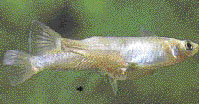
Above is the Albino Medaka the reg is brown. And come with the Arrowanna Power Update. And currently only in Japanese. It is used for food to the evil Arrowanna Fish.
Easy Keeping and Easy Breeding.
They Breed and Breed and Breed!
Real Info and Pic
(Synonym: Oryzias, medaka, Japanese killifish, medaka killifish, ricefish, MF) temperature of 25 oC - 28 oC Well or pond water is perfectly satisfactory. Tap water cannot be used immediately after it is drawn, because it is usually treated with chlorine and other chemical agents. By drawing a quantity of tap water and exposing it to sunlight for 2 or 3 days or allowing it to stand longer, it then becomes fit for use because volatile chlorine will have evaporated within that period. Bubbling of air quickens elimination of chlorine. For a rapid remedy for harmful chlorine, addition of 0.1- 0.3 gm of sodium hyposulfite, Na2S2O3, per 10 liters is generally recommended. Although habitats of the medaka are mainly waters of low lands and brackish water, it is also known to inhabit tide pools of coasts of certain regions in Japan and Korea. The medaka withstands a wide range of salinity, and a diluted sea water is rather better than the fresh water. In indoor culture, therefore, the use of a balanced salt solution is recommended, if the tap water proves to be unsuitable. Rugh (1948) suggested use of the following salt solution: NaCl, 1.0 gm; KCl, 0.03 gm; CaCl2, 0.03 gm; MgCl2, 0.08 gm; and distilled water to 1 liter. This solution is osmotically equivalent to about 0.02 M NaCl solution (1/25 of sea water) and is quite satisfactory. However, the use of a "bicarbonated" distilled water may be recommended (0.02 gm of NaHCO3 per liter, pH 7.3) in making the above mentioned solution. Practically, it is convenient to make the following stock solution, which is osmotically equivalent to a 1 M NaCl solution: NaCl, 500 gm; KCl, 15 gm; CaCl2, 15 gm; MgSo4, 40 gm; and distilled water to 10 liters. This solution is diluted to 1/50 with "bicarbonated" distilled water of pH 7.3. For rearing of eggs, the balanced salt solution equivalent to 0.133 M NaCl solution (pH adjusted to 7.3) is better. Keeping one or more extra containers filled with reservoir water is recommended. These may be placed close to fish-containing aquaria, and used for changing water. This procedure is desirable for two reasons: first, because the harmful effect of chlorine is avoided, and second, because the same temperature as that of fish-containing aquaria is obtained. For the latter reason even when using a balanced salt solution, keeping a reservoir is preferable. Any sudden change in water temperature may prove fatal to fish. Temperature Since the medaka is native to the Far East, it can withstand the winter in temperate zones without artificial heat. This fact gives it a higher scientific value than other tropical fishes. In temperate climates, the stock can be kept in out-of- door conditions throughout the whole year. They can survive at a wide range of temperatures, tolerating temperatures as low as 1 oC. The maximal thermal point is 37 oC - 38 oC. Temperatures of 25 oC - 28 oC have been found to be suitable for breeding. In Tokyo and Nagoya, the breeding season extends from mid-April to mid- September. If a temperature of 25 oC -28 oC is controlled by artificial means, maturation is quickened and the seasonal reproductive habit is destroyed; spawning can then be induced in any season even winter. The fish can stand a wide range of temperature fluctuations providing the change is gradual; sudden changes of temperature are harmful to fish.
|
|
|
|
|
|
|
|
|
|
|
|
|
|
|
|
Life
|
900
|
|
Juvenile
|
62
|
|
Breeding
|
100
|
|
|
|
